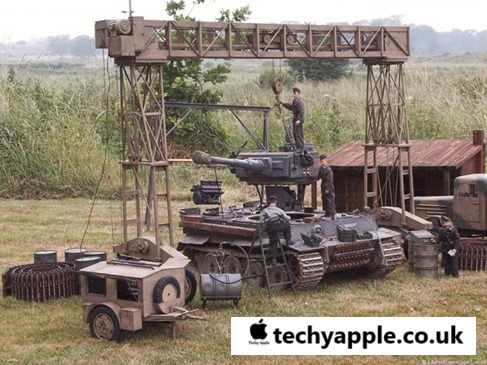WWII German Railway Gantry Crane: Engineering Marvel of Wartime Logistics
Introduction
During World War II, Germany relied heavily on railway transportation to move troops, supplies, and military equipment across vast distances. One of the key engineering solutions that supported this logistical effort was the WWII German railway gantry crane. These massive cranes played a crucial role in loading and unloading heavy cargo, including tanks, artillery, and supplies, ensuring that the German war machine remained operational.
In this article, we’ll take a deep dive into the history, design, and significance of the WWII German railway gantry crane. Whether you’re a history buff, an engineer, or just someone fascinated by wartime innovations, you’ll find plenty of intriguing details here.
The Role of Railway Gantry Cranes in WWII
Railways were the backbone of military logistics during WWII, and railway gantry cranes were essential for handling heavy loads. These cranes were typically installed in railway yards, supply depots, and industrial zones, helping to move large and bulky military equipment efficiently.
Why Were Gantry Cranes Important?
- Heavy Equipment Handling: The German army used heavy tanks like the Panzer IV, Tiger I, and Tiger II, which required specialized cranes for transportation and maintenance.
- Fast Deployment: Railway gantry cranes sped up the loading and unloading process, ensuring that military supplies reached the frontlines quickly.
- Strategic Railway Use: Germany depended on railway logistics, especially in occupied territories, where roads were unreliable.
Design and Features of WWII German Railway Gantry Cranes
German engineers designed gantry cranes to handle the extreme weight and size of military equipment. These cranes typically had the following features:
1. Massive Steel Framework
German railway gantry cranes were built with a heavy-duty steel structure, allowing them to lift immense loads, sometimes exceeding 100 tons.
2. Track-Mounted Mobility
Unlike stationary cranes, rail-mounted gantry cranes could move along railway tracks, increasing their versatility and operational range.
3. Counterweight Systems
To maintain balance while lifting heavy loads, these cranes used advanced counterweight mechanisms, ensuring stability during operation.
4. Electric and Steam-Powered Variants
Depending on their location and availability of resources, some cranes were steam-powered, while others used electric motors for lifting operations.

Notable Uses of WWII German Railway Gantry Cranes
During WWII, railway gantry cranes were deployed in multiple strategic locations. Here are some notable examples:
1. Tank Transport and Maintenance
Germany’s heavy tanks, including the Tiger and Panther, required specialized railway transport. Gantry cranes were used to load and unload these tanks from railcars.
2. Supply Depots and Ammunition Handling
Large-scale supply depots relied on gantry cranes to move heavy artillery shells, fuel barrels, and spare parts for vehicles and aircraft.
3. Naval and U-Boat Logistics
Some railway gantry cranes were used in naval shipyards, where they assisted in moving submarine components, torpedoes, and ship supplies.
Challenges and Limitations
Despite their advantages, German railway gantry cranes had some limitations:
- Vulnerability to Air Raids: Large railway yards with gantry cranes were prime targets for Allied bombing campaigns.
- Railway Dependence: If railway lines were damaged or destroyed, these cranes became useless.
- Complex Maintenance: Keeping these cranes operational required skilled engineers and a constant supply of spare parts.
Legacy and Modern Influence
While WWII ended in 1945, the influence of German railway gantry crane technology continues today. Many modern container cranes and industrial lifting systems use similar design principles. Some surviving WWII-era cranes have been restored and can be seen in museums and historical railway sites.
Conclusion
The WWII German railway gantry crane was an engineering marvel that played a crucial role in military logistics. These cranes enabled the quick movement of heavy equipment, ensuring that Germany’s war machine remained supplied and operational. While they faced challenges, their impact on wartime logistics and engineering innovations remains undeniable.
If you’re interested in historical machinery, visiting railway museums or studying surviving wartime infrastructure can provide an even deeper appreciation for these incredible engineering feats.
FAQs About WWII German Railway Gantry Crane
1. What was the purpose of WWII German railway gantry cranes?
German railway gantry cranes were used to lift and transport heavy military equipment, including tanks, artillery, and supplies, across railway networks.
2. How much weight could these cranes lift?
Some of the larger railway gantry cranes could lift over 100 tons, making them essential for handling heavy tanks and machinery.
3. Were these cranes used outside of Germany?
Yes, German railway gantry cranes were deployed in occupied territories, particularly in France, Poland, and the Soviet Union, to support military operations.
4. What happened to these cranes after WWII?
Many were either destroyed during the war, repurposed for civilian use, or scrapped for materials. Some have been preserved in museums.
5. Can you see any surviving WWII railway gantry cranes today?
Yes, some railway museums and military history sites have preserved WWII-era gantry cranes as part of their exhibits.
For a visual representation, you can watch the following video:






